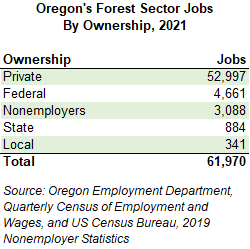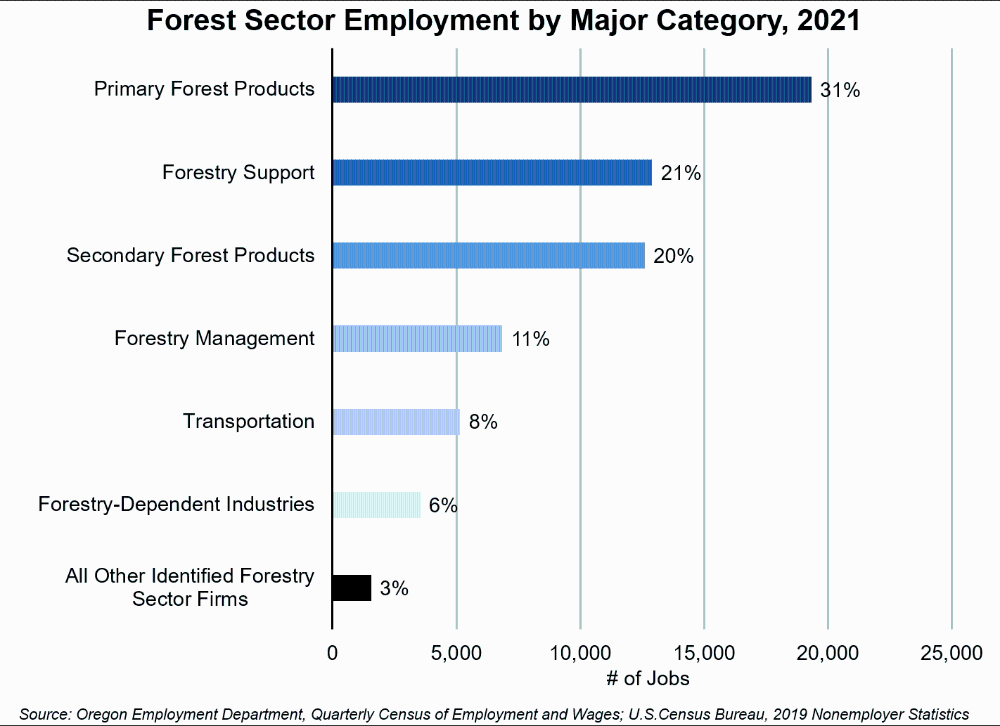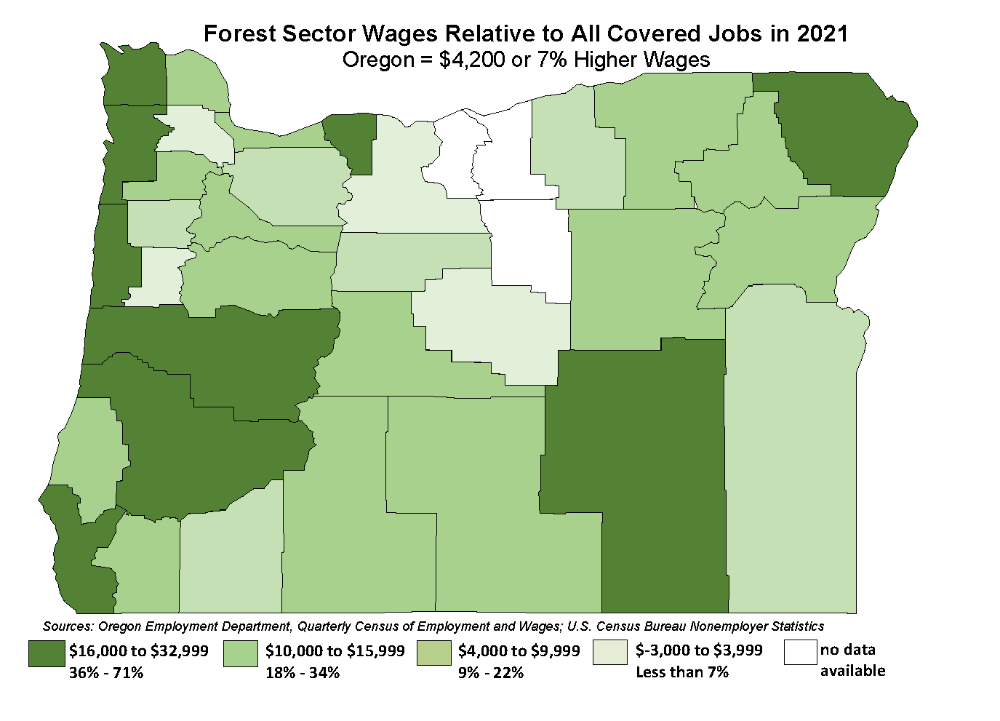Oregon’s Forest Sector Employment Totals 62,000 in 2021
November 28, 2022Forest sector-related employment in Oregon totaled 62,000 in 2021, which accounted for 3% of Oregon’s workforce. Forest-related jobs paid relatively well, with an annual average wage of $68,200, roughly 7% more than the $64,000 average wage for all jobs covered by unemployment insurance in 2021.
Categories of Forest Sector Employment
The majority of Oregon’s forest sector-related employment occurs in privately owned companies. About 53,000 forest sector jobs were found at private establishments covered by unemployment insurance in 2021. Another 3,000 private nonemployers operated in forest-related industries in 2019, the most recent year with available data. Federal, state, and local government accounted for 5,900 forest sector jobs statewide.

Oregon’s forest sector falls into five major categories: primary forest products; secondary forest products; forest management; forestry support; and forestry-dependent industries. Primary forest products made up almost one-third of the forest sector total with 18,800 jobs and 530 nonemployers. Within primary forest products, sawmills, softwood veneer and plywood manufacturing, and paper manufacturing accounted for 76% of all jobs.

Forestry support accounted for another 21% of forest sector employment, with 10,900 jobs and 1,900 reported nonemployers. Of those, almost half (48%) were found in logging. Support activities for forestry – which includes establishments engaged in forestry economics, forest firefighting, and estimating timber, among other things – made up roughly another 40% of employment in this category.
Similar to primary forest products and forestry support, Oregon’s 12,200 jobs and 450 nonemployers in secondary forest products were concentrated into a couple of industries: millwork (40%), and wood kitchen cabinets and countertops (30%).
Unlike other categories of forest sector employment, the majority of Oregon’s 6,800 forestry management jobs were found in government. Timber tract operations mostly consisted of jobs at the U.S. Forest Service. The other large forestry management industry was administration of conservation programs, which mostly included jobs at the Bureau of Land Management, Oregon Department of Forestry, and in the administration portion of the U.S. Forest Service. The largest source of private employment in forestry management was in corporate offices of forest sector-related firms with most of their employment in other categories.

Wood product transportation jobs consisted of 5,100 jobs at business establishments (not already found in other categories) in Oregon with log or chip trucks actively registered at the Oregon Department of Transportation. The 3,500 forest sector jobs in forestry-dependent industries were mostly represented by lumber, plywood, millwork, and wood panel merchant wholesalers. Other identified forest sector establishments included 1,500 jobs in various industries ranging from biomass power generation to marine cargo handling, consulting services, and support services, among others.
Importance of Forest Sector Jobs in Rural Oregon
Oregon’s 62,000 forest sector jobs made up roughly 3% of all employment in 2021. About 42,300 (68%) of those jobs were found at establishments in metropolitan counties, while 18,900 forest-related jobs (31%) belonged to businesses in rural counties. Another 720 jobs (1.2%) were with employers either classified in multiple areas, or unclassified locations.
Although metros accounted for twice as many of these jobs, forest sector employment made up 7% of all rural employment, compared with 2% of all metropolitan area employment. In Grant County, one out of every five jobs (20%) was forest-related. The sector accounted for more than 10% of total employment in Crook, Douglas, Jefferson, and Lake counties.

The forest sector also held relative importance to rural Oregon in terms of wages. In metropolitan areas, forest sector wages sometimes paid less than the annual average for all jobs, but could also pay as much as 40% more. Meanwhile, forest sector jobs in rural areas paid as much as 71% more than the average for all jobs. That was the case in Clatsop County, where forest sector jobs paid an average of $77,900, compared with $45,500 for all jobs. Lincoln County was similar, with an average annual forest sector wage ($76,000) that was 65% above the all-job average ($46,000).
Even at the county level, this breakout likely understates the importance of forest jobs to rural Oregon. That’s because “metropolitan” includes all jobs throughout the 13 counties that are a part of the state’s eight metropolitan areas, even if the non-metropolitan balance of the county is rural in character.
More Forest Sector Information
This forest sector research was undertaken in partnership with the Oregon Department of Forestry and Oregon Forest Resources Institute. More information can be found at oregonforests.org.